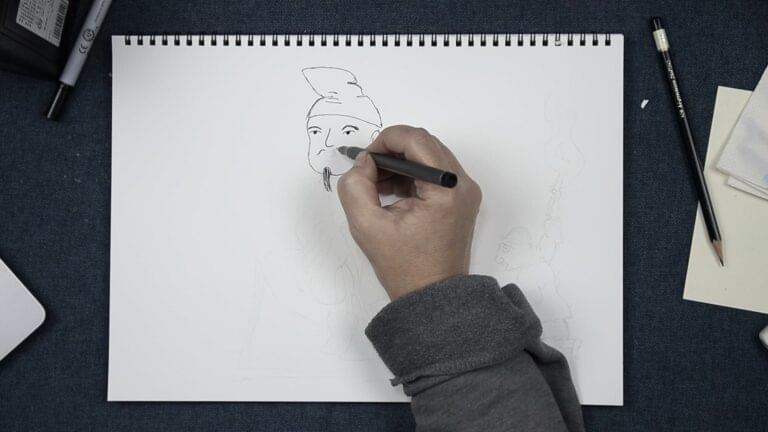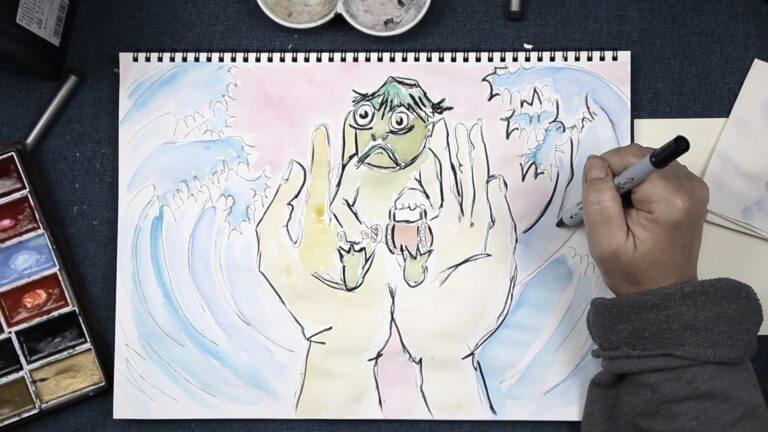Hey, hey. My name is Thersa Matsuura, author of The Book of Japanese Folklore and podcaster here at Uncanny Japan, my little space where I tell you about all the more obscure nooks and crannies of Japanese culture.
In today’s episode, I’ll be taking you on a journey that involves supernatural balance, a touch of kung fu fighting, cringeworthy acts of concentration, a lucky toy that heals disease and helps you achieve your dreams, and will end delightfully in a moment of sheer, utter unadulterated and quite literal zen.
The Mysterious Baby from Southern India
Let’s start with a baby, a mysterious baby, born in southern India in the 5th or 6th centuries as either a priest, a poor hunter, or into the warrior caste. He was a studious child who was drawn to Buddha’s teachings. Let’s call him Bodhidharma.
Little Bodhidharma grew up and set off to travel to China to teach what he had learned. At this time in history, Buddhism there was a lot of fancy-schmancy rituals and scholarship-type stuff. Bodhidharma was somewhat of a rebel. He was into meditating and focusing the mind. Insight over theoretical knowledge was more his vibe.
It’s interesting to note that in almost all the depictions of him during this time, he looks grumpy, has a thick dark beard and blue eyes. There are even some ancient Chinese texts that call him the blue-eyed barbarian, but it might be more correct to think barbarian just means foreigner, not some rogue madman.
So Bodhidharma was a real person, but as with many great historical people, parts of his life and adventures morphed into fantastic stories and myths and wonder, as you’ll see in a second.
Emperor Wu and the Crossing of the Yangtze River
After entering China, Bodhidharma met with the Emperor Wu. Emperor Wu was a devout Buddhist and extremely proud of all the merit he was building up. He bragged about things like constructing this temple and that temple, ordaining a bunch of monks and spending hours copying sutras, Buddhist prayers.
He asked this blue-eyed, bushy-bearded barbarian, “Bodhidharma, what have you done?” Bodhidharma calmly replied, “Nothing whatsoever.” The point he was probably trying to cheekily make is that you can’t just gain enlightenment by building a temple and doing all this external stuff. The sarcasm wasn’t lost on Emperor Wu. He was shocked by the reply and furious, too.
Bodhidharma didn’t stick around to see what a powerful, angry Chinese emperor could do. He quickly set off again. He reached the Yangtze River and found there was no way to get across. That didn’t stop Bodhidharma, though. He was resilient. He plucked up a reed, dropped it into the water, and stepped on it. You’ll find quite a few beautiful pieces of art of Bodhidharma crossing the river, balancing gracefully on a thin reed.
The Shaolin Temple and Nine Years of Meditation
He then retreated into a secluded cave that just happened to be near the famous Shaolin Temple. Evidently, at the time, the Shaolin monks weren’t the incredible warriors that we know they are today. They were kind of weaklings. Bodhidharma took care of that. Some stories say he taught them martial arts. Others say that he just taught them important breathing exercises to increase and use their energy or “qi” or “chi.” “Qigong” in Chinese, “kikō” in Japanese.
He then returned to his cave where he sat in meditation for nine years. He sat for so long that his legs fell off. Not kidding, it happened. And that’s not all. He grew frustrated that whenever he meditated, he got sleepy. So in a fit of something, I hope it’s not rage because he’d been meditating for quite a long time by this point and I’d like to think he was more chill than that. But anyway, he tore off or he cut off his eyelids so he couldn’t sleep and he tossed them aside, where they proceeded to grow into the first tea plants, which, conveniently enough, is something you drink when you want to stay awake.
The Foundation of Zen Buddhism
What Bodhidharma is mostly known for isn’t being legless or eyelidless or teaching martial arts or breathing techniques to Shaolin monks. No, Bodhidharma is the one whose teachings laid the groundwork for Chan in Chinese, or you might know it better in Japanese, Zen.
While most agree Bodhidharma himself never made it as far as Japan, his teachings did. It’s also interesting to note here that if you look down through history, Buddhism, as it came from India and was practiced in China, most likely got influenced from Chinese Taoism, which formed what is what we know as Zen today. Taoism believes in things like wu-wei, effortless action, harmony with nature, and deep meditative practices, which tracks.
Anyway, before we get to the cool Zen stuff in Japan, what happened to Bodhidharma? It’s a mystery. Some say he just disappeared. Some say that he returned to India. One Japanese Buddhist sect called Tendai believes he actually did travel to Japan and met Prince Shōtoku Taishi, who loved Buddhism himself.
But my favorite story is the one that says he died in China and was buried in a tomb near Mount Song. However, some time after this, a Chinese official claimed to have seen him alive and walking in the mountains. This official asked where was he going, and he said, “Back to India.” One thing that impressed this encounter so clearly in the official’s mind was that Bodhidharma was carrying a single sandal, a very strange thing to be doing.
After telling his tale to others, they decided to open Bodhidharma’s tomb because, well, it just couldn’t be, could it? But it was. The tomb was completely empty, except for a single sandal.
Zen Buddhism Comes to Japan
This all happened around 530 CE. Buddhism didn’t make it to Japan until the late 12th or early 13th centuries, hundreds of years later. What happened is pretty much Japanese monks traveled to China to study Buddhism and brought what they learned home.
Eisai, 1141-1215, was the first to bring these Chan practices to Japan. He founded a sect of Zen called Rinzai in 1191. When you think Rinzai, think disciplined meditation. You sometimes see a monk whacking someone on the shoulder with a stick. That’s Rinzai. This isn’t as scary as it sounds, though. It’s just a way to snap you back to attention or into enlightenment. Because Rinzai believes in sudden enlightenment.
Rinzai also uses the kōan, which are those seemingly meaningless phrases that shake you from your normal way of thinking. What is the sound of one hand clapping? Does a dog have Buddha nature? Were you suddenly shaken into enlightenment? If not, let’s talk about Dōgen.
Dōgen, 1200-1253, on the other hand, also studied in China, and he returned and he started the Sōtō school in 1227. Sōtō Buddhism concentrates on sitting and a slower approach to enlightenment. I guess you could call it the mellower of the two. In the Sōtō sect, you meditate facing a wall, while in Rinzai you face the room.
Daruma Dolls – The Legless Symbol of Resilience
Now, Bodhidharma is called Daruma in Japanese. Does that ring a bell? You may have seen a Daruma doll before. These are usually round, red, white and black dolls with no limbs, because reasons. Some are weighted on the bottom so that they can be knocked over and they’ll just roll right back up to their upright position, a kind of tumbler doll.
This perfectly reflects a Japanese proverb, “Nanakorobi yaoki” (七転び八起き) “Fall down seven times, get up eight,” which is a very nice reminder for resilience and Daruma, don’t you think?
Daruma’s image as a toy, doll, or even coloring pages was used in ancient Japan as a talisman against smallpox. For one, the getting up after being knocked down is kind of what you want to happen after you’ve been sick. And number two, the color red was, depending on the time, a color that warded off disease or appeased the smallpox deity so that it would leave you and you’d recover.
After vaccines were introduced in the late 1800s and smallpox disappeared, the Daruma dolls remained as a symbol of good luck. You can find them all over Japan even today, and they’re really a fun idea. They’re sold with both eyes wide and all white. No eyelids, right? After you get one, you color in the pupil of the doll’s left eye and you make a wish. You then put up your lucky Daruma to watch over and root for you until you work real hard with lots of resilience, falling down and getting up, falling down and getting up. And once you achieve your goal, you thank the Daruma by painting in the other pupil.
They’re used a lot for business, marriages, and politics. But since they come in all sizes, they can be used as personal good luck talismans too. I have one.
How to Practice Zazen Meditation
Which brings me to what Daruma was all about all along. Meditating. As someone who discovered a small zendō in Omaha, Nebraska back in the mid-80s and sat zazen, sitting meditation, for years until I came to Japan, I can tell you, he was onto something. Let’s do a little walkthrough of how it usually goes.
You sit either cross-legged in a half lotus or a full lotus, or on your folded legs in Japanese it’s called seiza. A zafu or small pillow can be used to make this more comfortable. It’s traditional to sit on the ground, but sitting properly in a chair is fine too. You want to be in a stable and relaxed posture, and wakeful. You don’t want to be sleepy. That’s what eyelid tea is for, or regular green tea if that’s not available.
Keep your back straight, chin slightly tucked, breathe through your nose, and press your tongue gently against the upper palate of your mouth. You keep your eyes open and gazing at a place around three feet in front of you. Also hold your hands in front of you, palms up, with your dominant hand on the bottom kind of cupping the other. Your thumbs should lightly touch. I was always told to pretend you’re holding an egg.
Now breathe, and pay attention to the sensation of breathing. Simple, right? Not. You’ll immediately find that your thoughts keep intruding, wandering, and suddenly you’ll have itches everywhere and magnified a thousand times. But don’t get frustrated or angry. Just bring your attention back to your breath, over and over and over again, just like the Daruma doll.
Now, do this every day for the rest of your life. You’ll have good days and bad days, but over time, you’ll…I don’t know how to describe it, but when I was meditating daily, it was at, hmm, how can I say it, like my best? It was like there was this stillness inside and all around me. I was very aware of everything, but all those emotions and feelings and thoughts that are always sneaking up and getting in the way and making me angry and do stupid things, they were all gone or at a very, very far distance.
It felt like how I imagined someone who is moving in a higher dimension would feel, like you have a lot of time to react to things, and also that that reaction, it’s going to be chill. You feel more in control of yourself, and at the same time, you start noticing and being incredibly awed and touched deeply by all the synchronicities of everything that’s happening around you. You notice more, and it’s more meaningful.
Okay, personal experiences may vary, but doing this episode reminds me I should get back to that place, or try to, or at least start sitting zazen again for 30 to 40 minutes a day. What a worthwhile way to start the year. And if you miss a day, don’t beat yourself up. You start again the next day. We need to be gentle with ourselves so we can be gentle with others. And don’t worry, your legs won’t fall off.
As Dōgen so famously said, “To study the Buddha way is to study the self. To study the self is to forget the self. And to forget the self is to be enlightened by the ten thousand things.”
Thank you all for listening, and I’ll talk to you again in two weeks. Stay safe and well. Breathe in, breathe out. Breathe in, breathe out. Breathe in, breathe out. Bye-bye.






